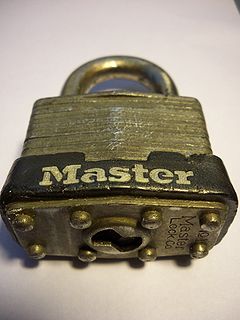Master Lock No 1: Difference between revisions
mNo edit summary |
Oaklandishh (talk | contribs) |
||
| Line 21: | Line 21: | ||
The No. 1 padlock uses the [[M1]] [[Key#Types_of_Keys|key blank]], but also can be made with a slightly different key profile. This change in profile helps to stop people from making copies of keys they shouldn't have. | The No. 1 padlock uses the [[M1]] [[Key#Types_of_Keys|key blank]], but also can be made with a slightly different key profile. This change in profile helps to stop people from making copies of keys they shouldn't have. | ||
A standard Master No. 1 padlock can be opened with a key both clockwise and counter clockwise, but due to a shrouding on the commercial series of this lock it can only be opened clockwise and makes picking it counterclockwise require TOK tension. | |||
== Disassembly instructions == | == Disassembly instructions == | ||
Revision as of 22:04, 17 August 2010
Master Lock No. 1
| Master Lock No. 1 | |
 | |
| Name | Master Lock No. 1 |
|---|---|
| Manufacturer | Master Lock |
| Lock Type | Padlock, Cylinder |
| Lock Design | Pin-tumbler |
The No. 1 is a pin-tumbler padlock made by Master Lock. The No. 1 uses a laminated padlock body with an internal key-in-knob cylinder. The inner cylinder uses four pin stacks and does not use any security pins. The No. 1 is one of the most common low security padlocks used in the United States.
Principles of operation
The M1 cylinder is a pin-tumbler lock with 4 pin stacks. It does NOT contain any security pins unless otherwise modified.
The No. 1 padlock uses the M1 key blank, but also can be made with a slightly different key profile. This change in profile helps to stop people from making copies of keys they shouldn't have.
A standard Master No. 1 padlock can be opened with a key both clockwise and counter clockwise, but due to a shrouding on the commercial series of this lock it can only be opened clockwise and makes picking it counterclockwise require TOK tension.
Disassembly instructions
The No. 1 cannot be disassembled non-destructively. To disassemble it, the rivets that hold the laminated body together must be removed and each layer removed individually. The inner cylinder itself can be disassembled in the same manner as a traditional pin-tumbler lock:
- Remove the cam or C-clip.
- Insert the key and turn the plug 45-90 degrees.
- Withdraw the plug from the cylinder. (A plug follower is recommended)
OR
- Remove the chamber casings and take out each pin-stack individually
- Remove the cam or C-clip.
- Withdraw the plug from the cylinder.
Notes
- The No. 1 cylinder requires a small diameter plug follower.
Vulnerabilities
The No. 1 is vulnerable to a wide range of attacks. The reduced pin tumbler count and poor manufacturing tolerances makes it an easy lock to pick. It's commonly given to locksport beginners as a "confidence lock"; a lock that is easy to open and inspires you to continue picking. The No. 1 may be vulnerable to one or more of the following:
